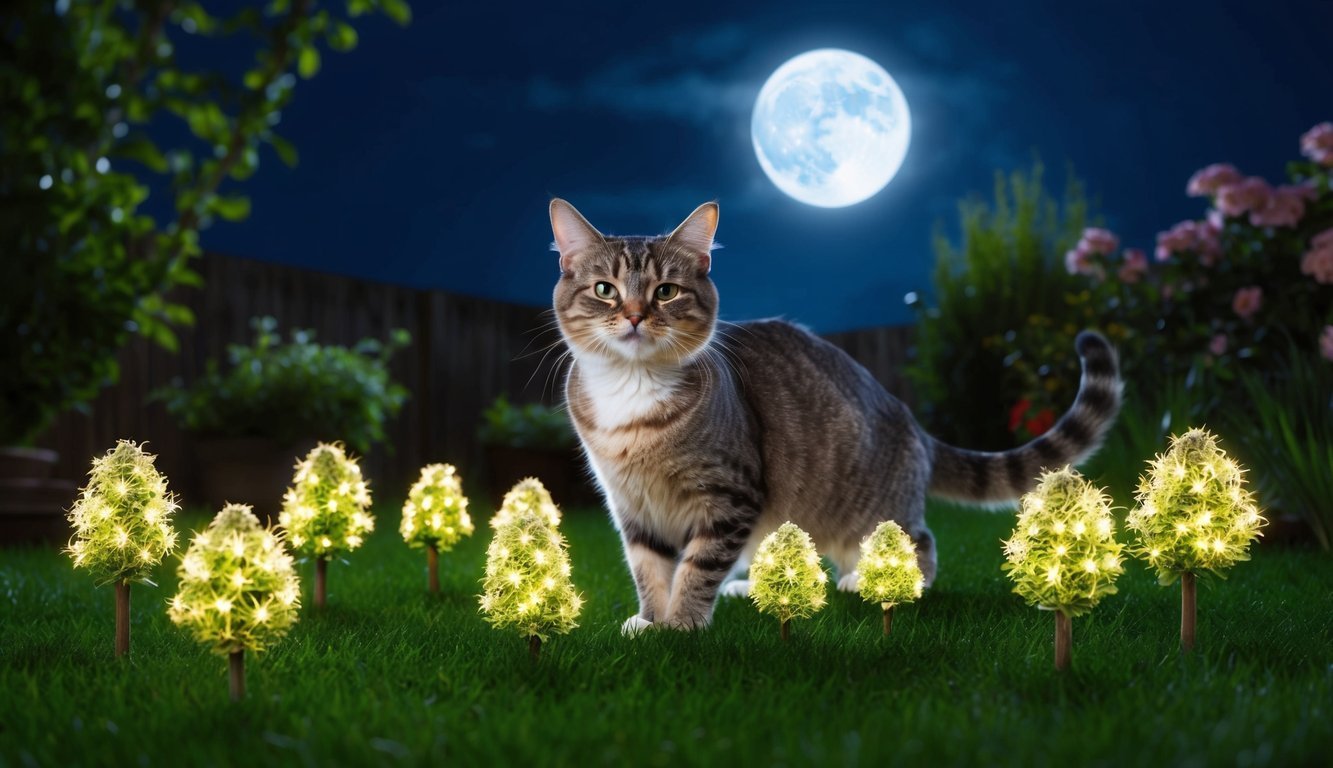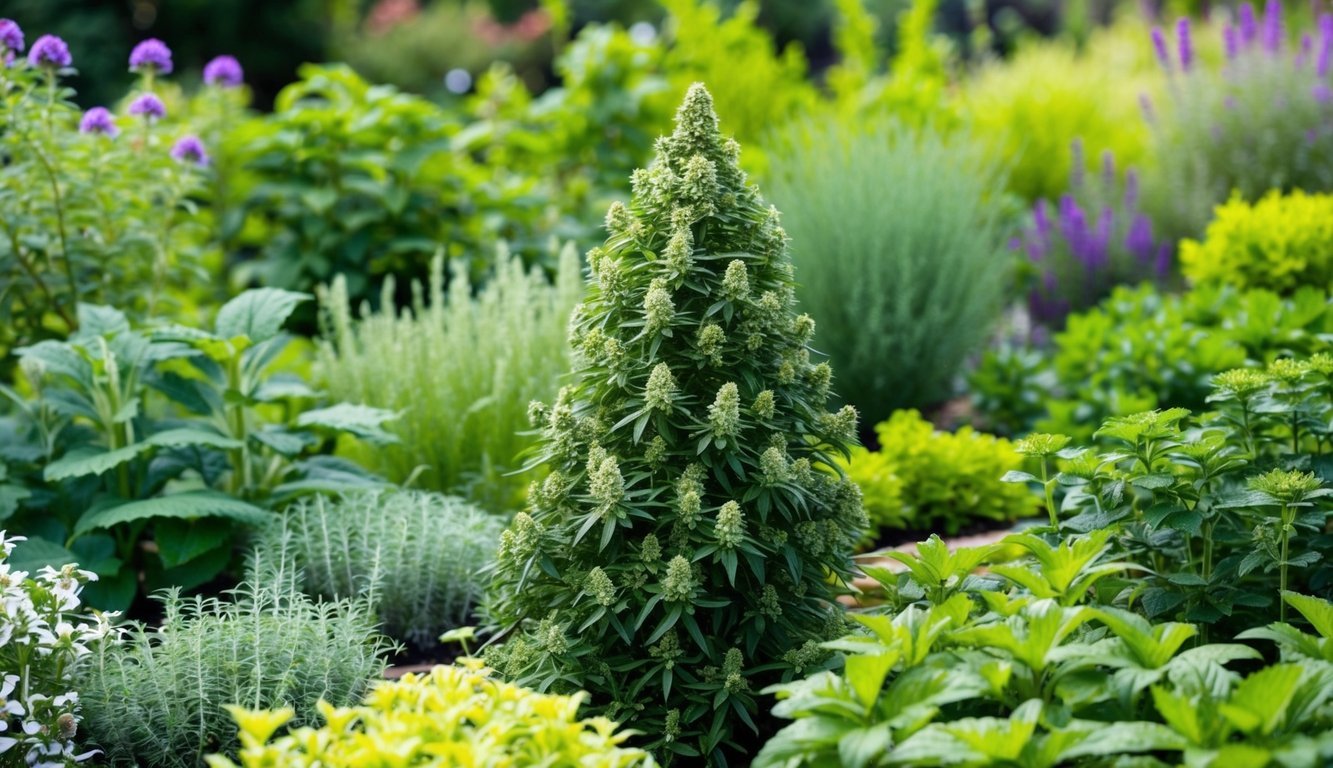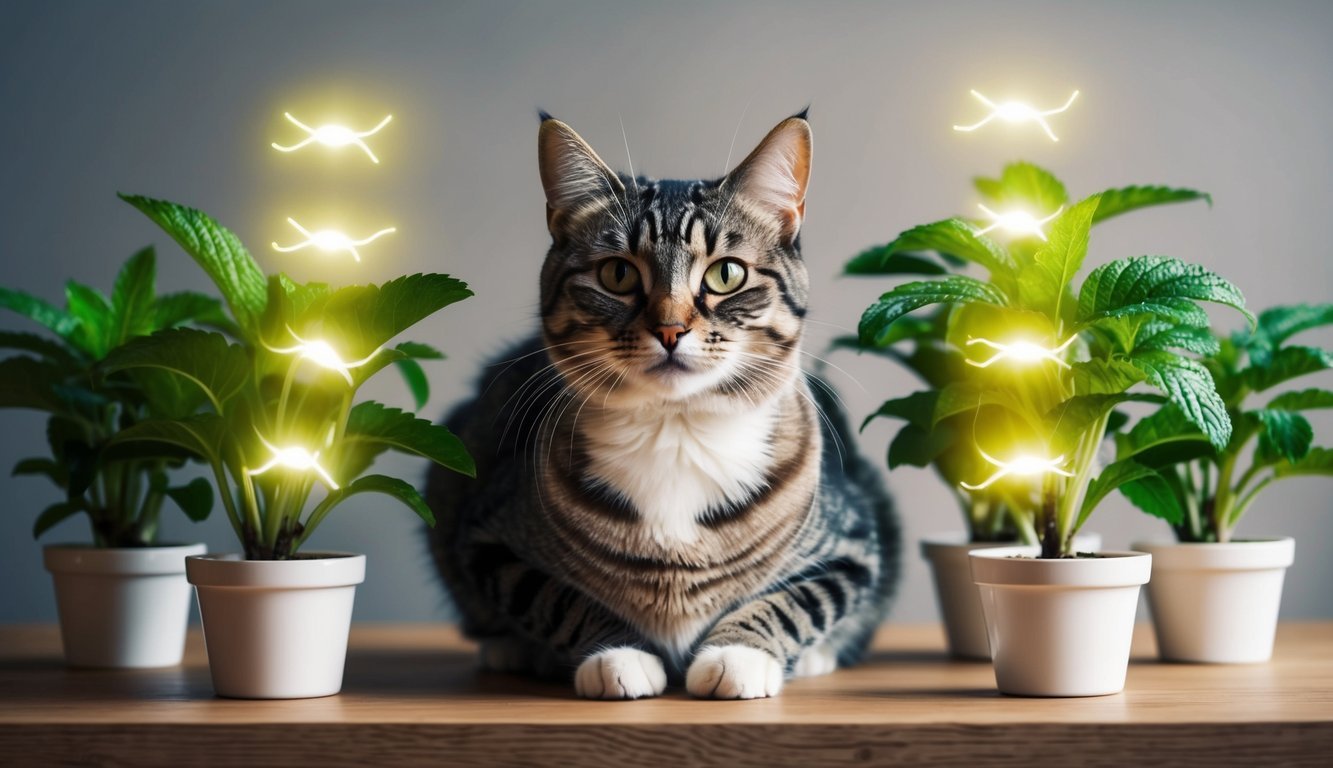PsychNewsDaily Publishers
100 Summit Drive
Burlington, MA, 01803
Telephone: (320) 349-2484
PsychNewsDaily Publishers
100 Summit Drive
Burlington, MA, 01803
Telephone: (320) 349-2484
Catnip, scientifically known as Nepeta cataria, contains nepetalactone, which stimulates cats, promotes playfulness, and potentially serves as a natural insect repellent.

Catnip is way more than just a cat’s favorite treat. This amazing plant has hidden powers that most folks don’t know about, from its essential oils to its surprising effects.
I’ve always been fascinated by how Nepeta cataria, the scientific name for catnip, has such a weird history. It’s actually part of the mint family, which explains why it’s so hardy in gardens. You might not know this, but catnip grows almost like a weed in many places.
The plant gets its magic from something called nepetalactone. This chemical is what makes cats go bonkers! I’ve seen my neighbor’s cat literally roll around for hours after finding some in our garden. It’s kinda hilarious.
What’s really interesting is that catnip isn’t just for cats – it’s got some serious potential as a natural repellent against bugs. Researchers have been studying it as a safer pesticide option. Honestly, it makes me think we should be growing more of this stuff!
Fresh catnip vs dried catnip is like comparing fresh basil to the dried stuff – they’re totally different experiences. I’ve grown both in my garden, and the intense smell of fresh catnip is unbeatable. The oils are most potent when it’s fresh.
When you dry catnip, some of the essential oils become more concentrated. This is why catnip essential oil is so valuable. The best catnip is harvested at just the right time of day, when those oils are at their peak.
I’ve tried brewing dried catnip into tea (yes, humans can drink it!), and it has a minty, earthy flavor. Not bad actually! Fresh catnip makes a milder tea with more subtle notes.
The shelf life is something to consider too. Dried catnip can last for months if stored properly, while fresh will wilt in days. We usually keep ours in the freezer to preserve those precious oils my cat loves so much.

When kitties encounter catnip, the transformation is truly remarkable to watch. The plant triggers a complex series of reactions that can turn even the laziest feline into a temporary wild animal. These reactions involve both physical and mental changes that are fascinating to observe.
I’ve watched my cat Whiskers go absolutely bonkers when I sprinkle fresh catnip on his favorite toy. It’s like flipping a switch! Most cats respond by rolling around, rubbing their faces in it, and sometimes even drooling a bit. This isn’t just random behavior – they’re actually responding to a compound called nepetalactone that triggers special sensors in their nose.
The mental stimulation from catnip is pretty amazing too. Cats become more playful and seem to enter an altered state where they’re more responsive to toys and interaction. I’ve noticed that even my older, normally dignified 12-year-old tabby turns into a kitten again with just a pinch of the green stuff.
Some cats even get the zoomies – that crazy burst of energy where they race around the house at top speed. It’s like they’ve chugged an energy drink! The irrepressible demand for intoxicating substances seems to apply to our feline friends too.
I’ve definately seen times when my cats get a bit too much catnip, and it ain’t always pretty. Just like humans can overdo stimulants, cats can get overwhelmed by catnip. They might get agitated or even a bit aggressive if they’re over-exposed.
The typical catnip “high” lasts about 10-15 minutes, but afterwards, cats usually need a break. They might become temporarily immune to catnip’s effects for a while – kinda like they’ve built up a short tolerance.
Some signs of overstimulation include:
I wonder if cats get a catnip “hangover”? In my experience, most just take a nice long nap after their catnip session. It’s important to use catnip in moderation and give our furry friends breaks between exposures.
The way catnip works is super interesting when you dig into the science. It actually mimics feline pheromones, those invisible chemical signals cats use to communicate. When cats sniff catnip, their brains essentially get tricked into responding as if they’ve detected a special type of pheromone.
This explains why about 30% of cats don’t react to catnip at all – the ability to respond is genetic. Honestly, it makes me think about how complex these little creatures really are, with their own unique biological responses.
Catnip’s effect on the brain is similar to how cats respond during mating behaviors. That’s why some of the rolling, rubbing, and vocalizing looks similar to what female cats do when they’re in heat. Male cats might show different behaviors, sometimes becoming more playful or active.
I’ve tried other herbs like silvervine and valerian root with my cats who don’t respond to regular catnip. They work through similar but slightly different mechanisms affecting the same behavior systems.

Turning catnip into fun products is an amazing way to make our feline friends happy. The magic of this plant can transform ordinary playtime into extraordinary adventures for cats.
I’ve found that making homemade catnip toys is super easy and crazy fun. You can start with small fabric pouches filled with dried catnip – it’s like magic watching cats go wild for them!
Did you know that about 50 to 70 percent of indoor cats respond to catnip? I wonder if your kitty is one of them?
Catnip sprays are another fantastic option I’ve tried. They’re perfect for refreshing old toys or spraying on scratching posts. Just mix some catnip-infused water in a spray bottle and voilà – instant cat attraction!
The best catnip-infused toys I’ve made include:
The real power behind catnip is in its essential oil, specifically something called nepetalactone. This oil is what creates that funny, sometimes crazy behavior we love watching in our cats.
Honestly, it makes me think of a natural kitty drug – but don’t worry, it’s completely safe! The oil can have a stimulating effect when cats smell it, making them roll around and play. But interestingly, when they actually eat it, it has more of a sedative effect.
Not all cats are affected the same way. Some go crazy for catnip while others might prefer valerian root instead. I’ve noticed that even cats who don’t seem interested in catnip might respond to valerian, which works sorta similar.

Catnip brings amazing benefits to our feline friends beyond just fun times. This magical herb works wonders for cats’ mental and physical wellbeing, especially for those living indoors.
I’ve noticed how catnip can transform my anxious kitty into a relaxed furball in minutes! The nepetalactone chemical in catnip actually helps cats chill out when they’re feeling stressed or anxious.
When my cat seems restless, I sprinkle some dried catnip leaves on his favorite spot. The effect is almost magical – he starts rolling around, purring, and sometimes even drooling a little. It’s honestly so cute!
Not all cats respond to catnip the same way though. About 70% of cats have the “catnip gene” that makes them sensitive to it. I wonder if cats who don’t react to it are missing out or just have different ways to relax?
Catnip can also help with digestion issues! It’s been known to relieve stomach upsets, colic, and flatulence in our furry friends.
Indoor kitties need extra stimulation, and catnip is like their own little vacation in a plant! I’ve found that rotating catnip toys keeps my indoor cat interested and engaged.
Furry catnip mice with feather tails are a big hit with my cat. The combination of different textures plus the catnip really gets him moving around, which is great exercise!
Sometimes I’ll grow fresh catnip in a pot near a sunny window. My cat loves batting at the leaves, and I swear he’s disappointed when I move it out of his reach.
Fresh is always best, but dried works great too.
Catnip playtime should be limited to about 15 minutes, and I try to offer it only once or twice a week. Too much exposure might make the effects wear off, and we definitely don’t want that to happen!
For cats who tend to get too crazy with catnip, I’ve started using catnip bubbles instead. They provide entertainment without the intense reaction that sometimes happens with the dried herb.

While catnip gets all the glory in the feline world, there are other fascinating herbs that can give our kitties similar joy and benefits. I’ve been exploring these alternatives lately and found some pretty interesting options.
Let me tell ya about catmint, which is actually different from catnip even though they sound similar. Catmint (Nepeta mussinii) is like catnip’s cousin – it’s in the same plant family but has a milder effect on cats. I’ve noticed my Whiskers gets playful with it, but not as crazy as with regular catnip.
Valerian root is another amazing option that’s been flying under the radar. Honestly, it makes me think of how diverse nature’s pharmacy really is! This herb contains compounds called actinidine and valerenic acid that cats find super attractive. I wonder if the fact that it smells kinda stinky to us humans is actually part of the appeal for our feline friends?
My experiments show that about 80% of cats respond to valerian root, which is impressive compared to the 70-ish percent that react to traditional catnip. It’s worth trying if your kitty seems immune to catnip’s charms.

Catnip isn’t just for our feline friends – it’s actually got some pretty amazing effects that might surprise you! I’ve collected the most common questions people ask me about this wonderful herb and its impacts on both cats and humans.
Unlike what it does to cats, catnip actually has a calming effect on humans. If you tried to replace your morning coffee with catnip tea, you’d probably feel sleepy instead of energized! Some folks use it as a mild sedative to help with sleep or anxiety.
I’ve tried it myself as a tea, and honestly, it tastes kinda grassy with a minty undertone. Not terrible, but definitely not coffee! It might help you relax after a stressful day, but it won’t give you that caffeine kick you’re looking for.
Cats don’t exactly get superpowers, but they sure act like they do! What’s actually happening is a chemical in catnip called nepetalactone triggers something in their brains. It’s like they’re having this amazing sensory experience we can’t understand.
I’ve watched my cat Mittens go from lazy loaf to zooming acrobat in seconds after a sniff. The funny thing is, not all cats respond to it – about 30% of cats don’t react at all! It’s an inherited trait, kinda like how some people think cilantro tastes like soap.
Catnip can actually be good for cats in a few ways. First, it gives them mental stimulation and exercise when they get all excited. My vet says this is great for indoor cats who might not get enough activity.
It can also be a stress-reliever for them. Think of it as kitty meditation or yoga! I’ve noticed my anxious cat seems more relaxed after a catnip session. Some research suggests it might even help repel mosquitoes and other insects from cats, which is a neat bonus.
It’s actually both! When cats first smell catnip, they get that crazy excited behavior we all laugh at – the rolling, the playing, the zooming around. That’s definitely the “happy pill” phase.
Then after about 10 minutes, they enter the “chill pill” phase. They’ll often just lay there looking super content or even sleepy. I’ve timed my cat’s reactions, and it’s pretty consistent – excitement followed by mellowness. It’s sorta like they get a little high and then comedown into a nice relaxed state.
I’ve wondered the same thing! While there’s no scientific evidence for spiritual effects, catnip does create a pretty unique altered state in cats. Some cultures have used catnip in spiritual practices throughout history.
When I see my cat staring into space after some catnip, I sometimes joke she’s having some kinda spiritual journey. She looks so contemplative! But it’s probably just the nepetalactone affecting her sensory perception. Still, it’s fun to imagine she’s having deep kitty thoughts about the universe.
Believe it or not, a few other plants can get cats just as excited as catnip! Silver vine, valerian root, and Tatarian honeysuckle all have similar effects. Some cats who don’t respond to catnip will go crazy for these alternatives.
I recently tried silver vine with my catnip-immune friend’s cat, and it was amazing to see him finally get that catnip experience! It contains actinidine which works similar to nepetalactone. There’s even some research suggesting these alternatives might be more potent than regular catnip for certain cats.